SOS: notes from a disappearing city
Ella Mudie
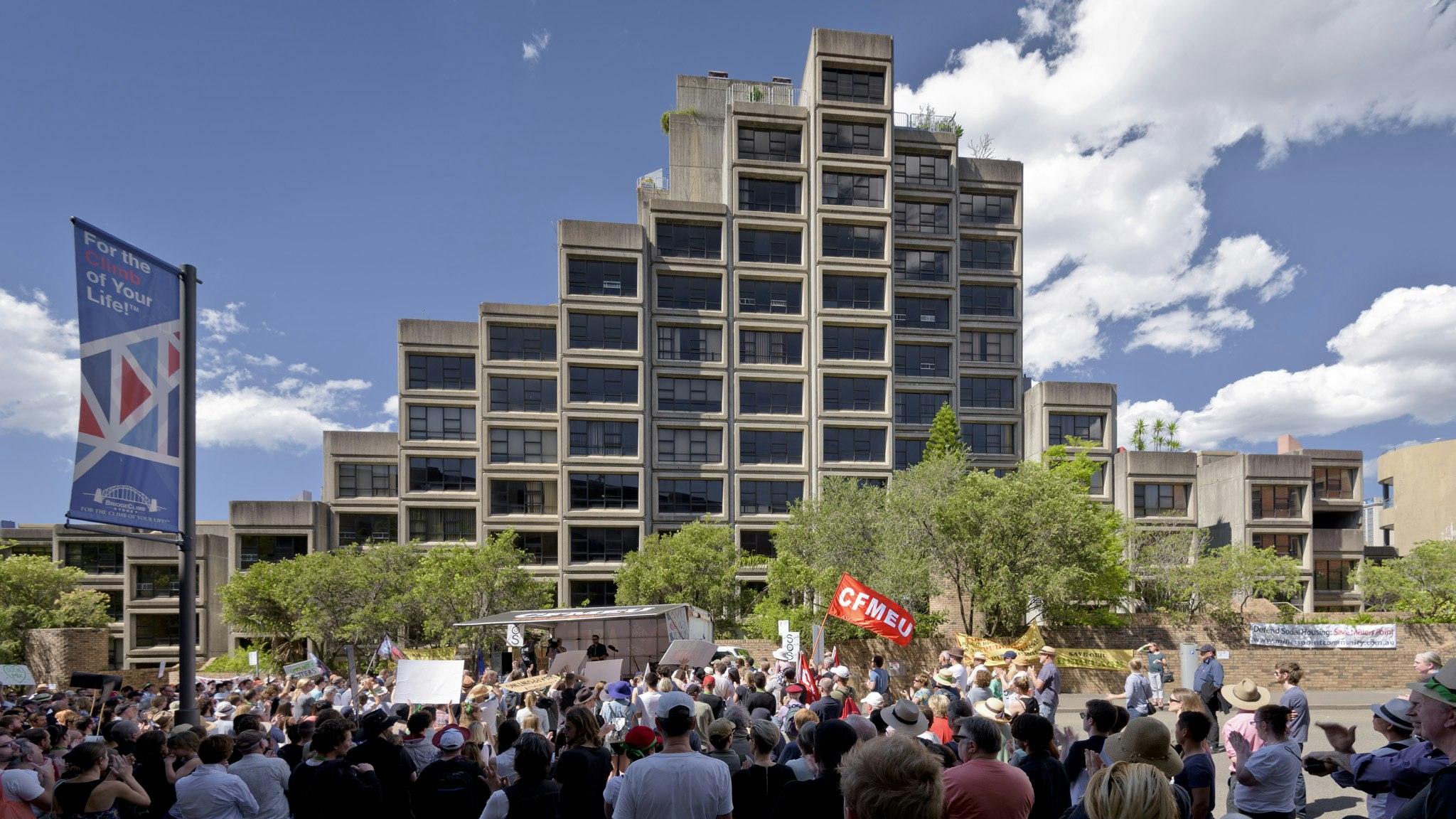
Sirius rally in front of the building, September 2016; photo: Ben Guthrie, courtesy of Save our Sirius.
When the Museum of Sydney (MoS) presented its strangely spectral exhibition Demolished Sydney twelve months ago, there was the sense of an ungovernable past resurfacing to disrupt the present. As an archive of the city’s lost buildings the exhibition proved not only prescient of the battles over threatened architecture now unfolding across the city but seemed also, in its own way, to galvanise these debates. As I was drawn back for repeat visits it struck me that where the vanished architectural structures documented at MoS might have been spectacularly rigged with dynamite or met the wrecking ball, today’s buildings are more likely to be discretely dismantled behind a veil of mesh netting. In the Sydney CBD and surrounds, nets are going up around the scores of buildings scheduled for such inconspicuous demolition to make way for the Sydney Metro rail project. While depictions of the interiors of the 1940s inter-war modernist residential block 7 Elizabeth Street, styled by the influential Australian designer Marion Hall Best (1905–1988), recently graced the walls of another MoS exhibition, the heritage-listed building is being readied for demolition.
Since I experienced my own brush with the rampant property speculation that rules Sydney when my home was abruptly offered for an immediate sale by its owner last year, I’ve observed the current state of play between housing, demolition and the arts with a certain intensity of empathy. How can one not be troubled by plans to knock down an entire public housing estate on the CBD fringe suburb of Waterloo? At The Rocks, the battle for the Sirius apartment building continues after the state government declined to heritage-list it for a second time, disregarding public enthusiasm over a recent favourable ruling in the New South Wales (NSW) Land and Environment Court (1). Here, the struggle now is to save the building—the community has already been moved on. I gather these notes all too aware, then, of the ambivalence that arises from Sydney’s ‘knock down and replenish’ attitude to the built environment.
My concern is to document the pockets of artist and community-led resistance that have emerged, giving pause for thought. At Waterloo, #WeLiveHere2017 is lending voice to the residents of the estate, humanising the debate on demolition and public housing just as the Save Our Sirius (SOS) campaign has worked tirelessly to turn around perceptions of the building as outmoded Brutalism. At the same time, the dismantling of Sydney’s inner-city public housing stock occurs side-by-side the springing up of private property developer-led ‘neighbourhood’ precincts at exponential speed. Not far from 4A Centre for Contemporary Asian Art in Haymarket one of the newest additions, Darling Square, is under construction. Like so much recent downtown urban renewal in Sydney and around the world, the development raises important questions around just how precarious is the struggle for spatial justice in global cities dominated by the consumer-focused neoliberal principles of new urbanism?
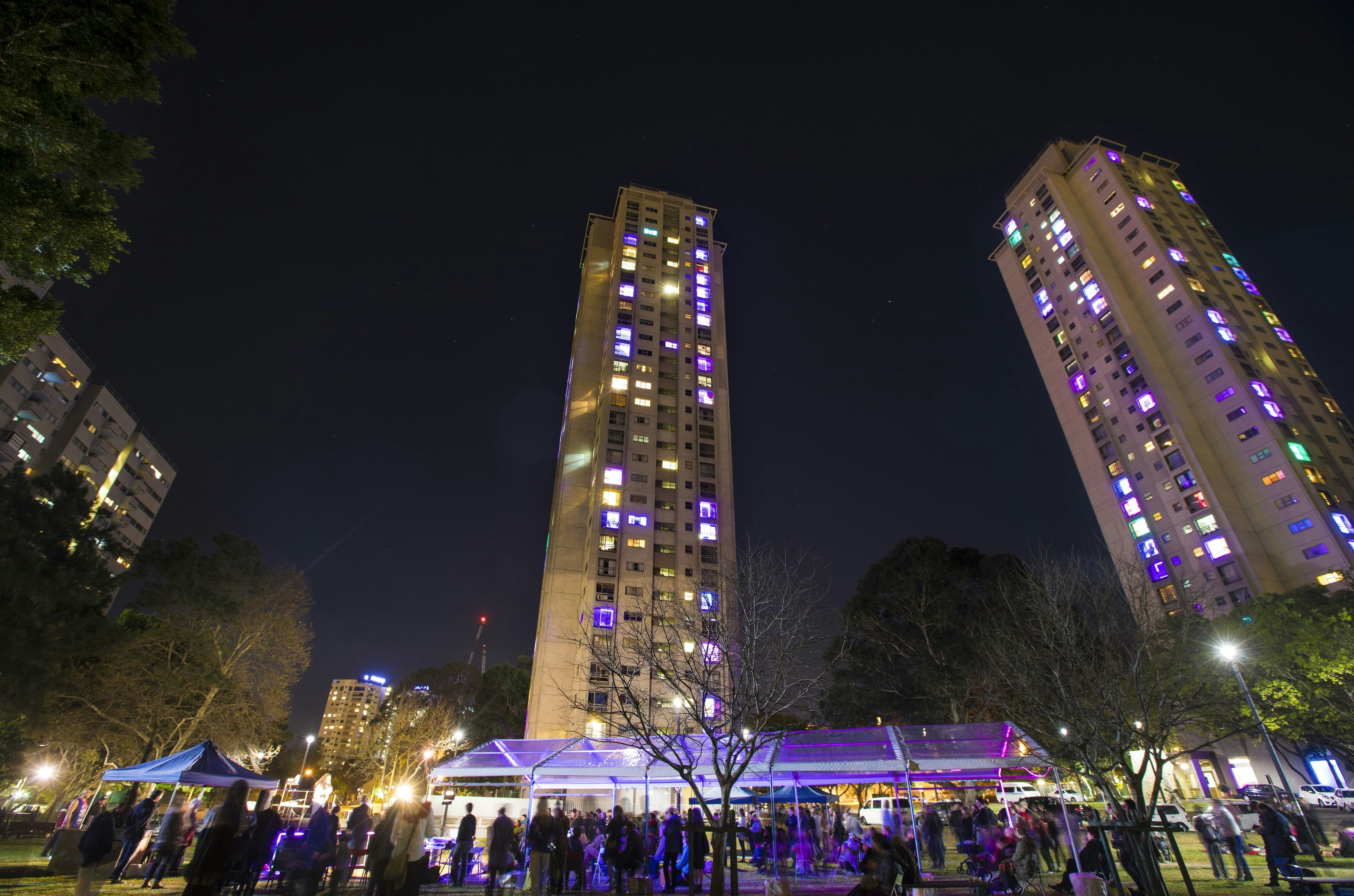
#WeLiveHere2017 launch event at the Waterloo estate, illuminated towers in the background; photo: Jessica Hromas, courtesy #WeLiveHere2017.
Precarity certainly defines the state of affairs at Waterloo where residents have faced uncertainty about their future since the NSW Government announced in late 2015 its plans to redevelop the 18-hectare estate, home to more than 4,000 residents, many of whom are elderly, disabled or high-needs. As the site selected for a new Sydney Metro station, and located on valuable government owned land just kilometres from the CBD, the suburb of Waterloo is slated for a massive urban renewal project that has attracted criticism for its proposed scale, which could see housing density increase to the highest levels in Australia (2). A mix of private and public housing with a 70:30 ratio is proposed. Despite assurances that there will be no overall reduction in the number of public housing dwellings, and that residents will have the right of return, the reality is that once such displacement occurs the character and fabric of an area is irrevocably altered.
Led by local arts producers, artists and volunteers, with support from the City of Sydney, #WeLiveHere2017 is a multi-faceted social action campaign initiated to generate discussion and to provide residents of the Waterloo estate with a platform for expressing—and protesting—their feelings about the redevelopment. Titled after the postcode for Waterloo (2017), to date the ongoing campaign has comprised a social archive in the form of photo-portraits of residents published on social media, a crowdfunded documentary film on the neighbourhood (release date still forthcoming), and a light art project presented in conjunction with Art & About in September. Adopting the motto, ‘the lights are on, somebody is home,’ five hundred residents had coloured LED lights installed around their apartment windows, temporarily reengineering the twin 30 storey Matavai and Turanga concrete towers (both completed in 1976), facing demolition as part of the redevelopment, into a community powered light sculpture.
Ahead of the launch of the light installation, #WeLiveHere2017 began gathering significant media attention. Just days out from the official event it made the cover of The Sydney Morning Herald with an arresting portrait of a tenant of one of the tower buildings, Henry Wilson, photographed in his sparsely furnished apartment bathed in a very Prince shade of purple. With his television switched on to an evening news broadcast, the face of NSW Premier Gladys Berejiklian appeared as if presiding over the fate of 73-year-old Wilson whom we learn in the article has lived in Waterloo for three months after an extended period of homelessness. Considering that public housing residents are by-and-large a faceless and voiceless minority in Australia, often stigmatised in the media, the prominence afforded to a sympathetic portrayal of the residents’ stories was striking.
The idea for the light installation, #WeLiveHere2017 producer Clare Lewis explains, ‘was for it to function as a kind of silent protest and act as a counterpoint to light projection events like Vivid Sydney, in the sense that here the lights would be coming from within the tenants’ homes’ (3). This inverse set-up—lights emanating from the building interior, projecting outward the moods and feelings of the tenants, thereby transforming the building into a kind of beacon or distress signal—reflected the broader concern of the project organisers that #WeLiveHere2017 be a community-led campaign in marked distinction to the top-down approach of government sanctioned consultation processes.
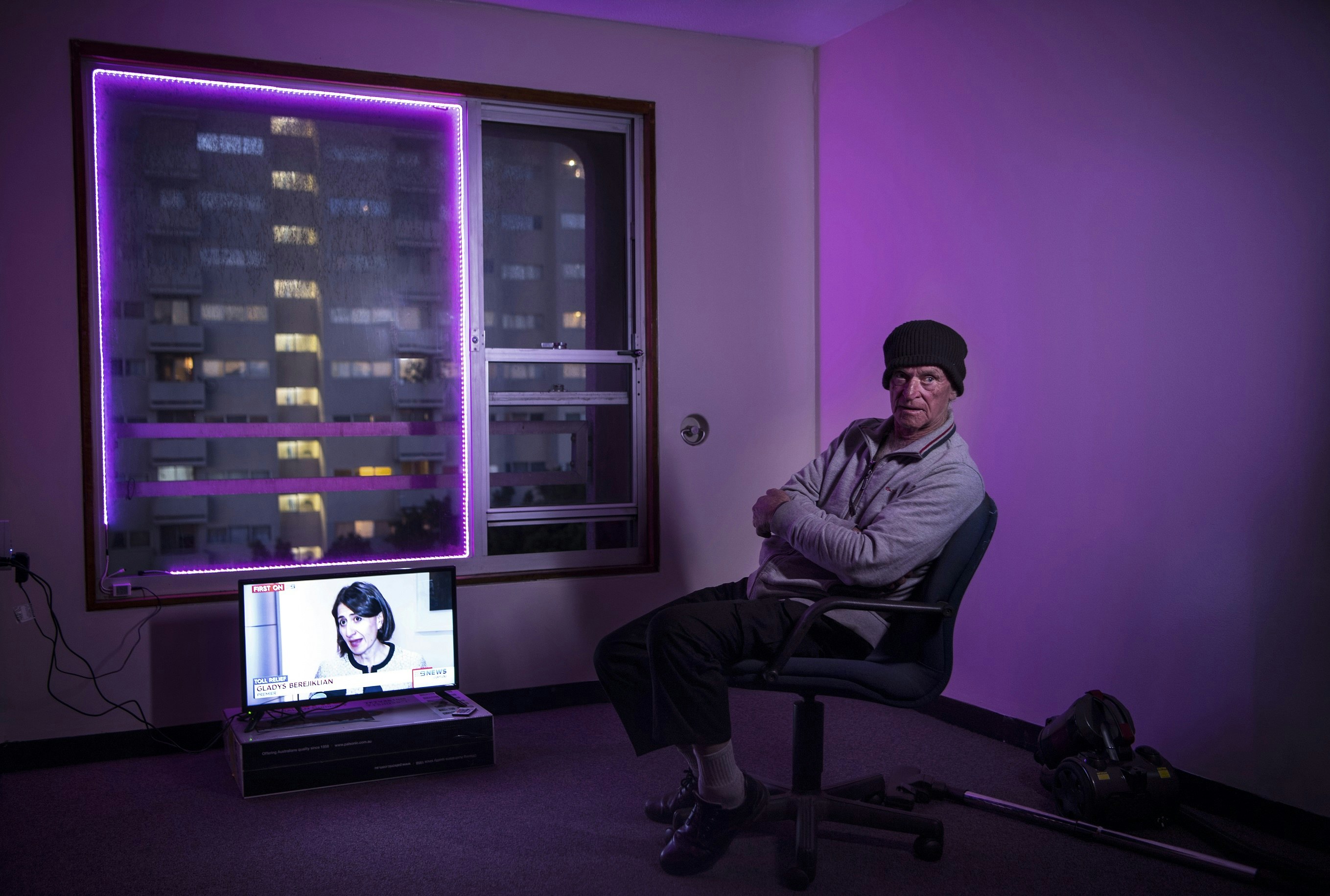
Waterloo resident Henry Wilson in his home; photo: Nic Walker, courtesy #WeLiveHere2017.
In his research into the dynamics of citizen versus government-led participatory planning, University of Sydney lecturer in the Faculty of Architecture, Design and Planning Dallas Rogers notes that ‘state-sanctioned community consultations provide local citizenries with limited opportunity to set the planning agenda or to hold decision-making power’ (4). This pattern has been observed at Waterloo where the barriers faced by residents to exercising meaningful input into their community’s redesign is by no means unique. Across the world, governments are moving to dismantle concentrated public housing with a view to dispersing residents across locales with a greater so-called ‘social mix’ (5). The trend more broadly reflects how neoliberalism sanctifies what Marxist geographer Edward Soja diagnoses as ‘the inalienable right to own property as the central principle in defining the capitalist nation-state, its system of laws, and its revised definition of citizenship. Human rights in general and such specific claims as the right to the city become subordinated to the primacy of rights to property’ (6).
A primary aim of #WeLiveHere2017 has been to provide a platform for more empowering and agential forms of citizenship participation. And yet, public art as a mode of participatory planning is not without its perils. When community planning events for #WeLiveHere2017 were better attended than the government’s official tenant consultation meetings, the project team noted the government representatives starting to mimic their approach. In a similar vein, the public platform that art projects grant to a local community is frequently a precarious one. In the case of #WeLiveHere2017, the contribution of public money to fund the installation meant the project proceeded with some trepidation as to just how easily a subtle form of protest and resistance might be recuperated into a celebration or worse, an endorsement, of the urban renewal of Waterloo.
The ease with which civic art actions can be instrumentalised by funding bodies, institutions and governments means that, as a rule, independence is imperative for artists seeking to bring about any material resistance in the public realm. Yet the efficacy of #WeLiveHere2017 suggests there are circumstances where public funding can be helpful when artists and organisers are sufficiently astute about their alliances and the underlying agendas of the actors at play. Given the City of Sydney Council’s adversarial position as watchdog to the NSW Government’s redevelopment proposals for Waterloo, their financial support of #WeLiveHere2017 has granted the campaign a certain freedom to voice protest and act as advocates for the local community. Such productive alliances are uncommon in Sydney, however, to the extent that civic art funded by property developers and government agencies tends to favour projects that reference the history or character of a site without any overtly disruptive intervention into the unequal redistribution that urban renewal sets in motion.
At The Rocks, the Millers Point sell-off by the NSW Government of its stock of heritage-listed public housing worker cottages and terraces reveals just how radically redefined the notion of citizenship has become in global Sydney. Walking the streets of the precinct just months after the residents’ evictions, an eerie mood of displacement and dispossession pervades the historic neighbourhood. Development application notices are pinned on the rusted front gates of row upon row of dilapidated houses. Along the water-fronting High Street, ephemeral eulogies are scrawled in white chalk across the terraces’ brown brick facades. ‘Pat lived here worked 47 years in hospital catering then forced out by Housing,’ reads one dedication. The presence of security guards is a reminder of the protest, anger and distress that resulted from fracturing such a highly-integrated community with generations of attachment to place.
Walking the streets of the precinct just months after the residents’ evictions, an eerie mood of displacement and dispossession pervades the historic neighbourhood.
At the nearby Sirius apartment building, completed in 1980 and now widely recognised as a Brutalist icon among the architecture fraternity, the struggle continues. As Sirius was not included in the original social impact study for the Millers Point sale, the announcement by NSW Government in 2015 of their intention to sell the building, with demolition attached to sale, came as a surprise. The former NSW Minister for Heritage, Mark Speakman, then failed to list Sirius on the state’s heritage register, despite the unanimous recommendations of the Heritage Council of NSW, on the basis that any reduction in the building’s sale value would subject the government to undue financial hardship. The unjustness of this decision, which showed blatant disregard for the advice of experts, became the catalyst for garnering support behind a community-led campaign to save Sirius.
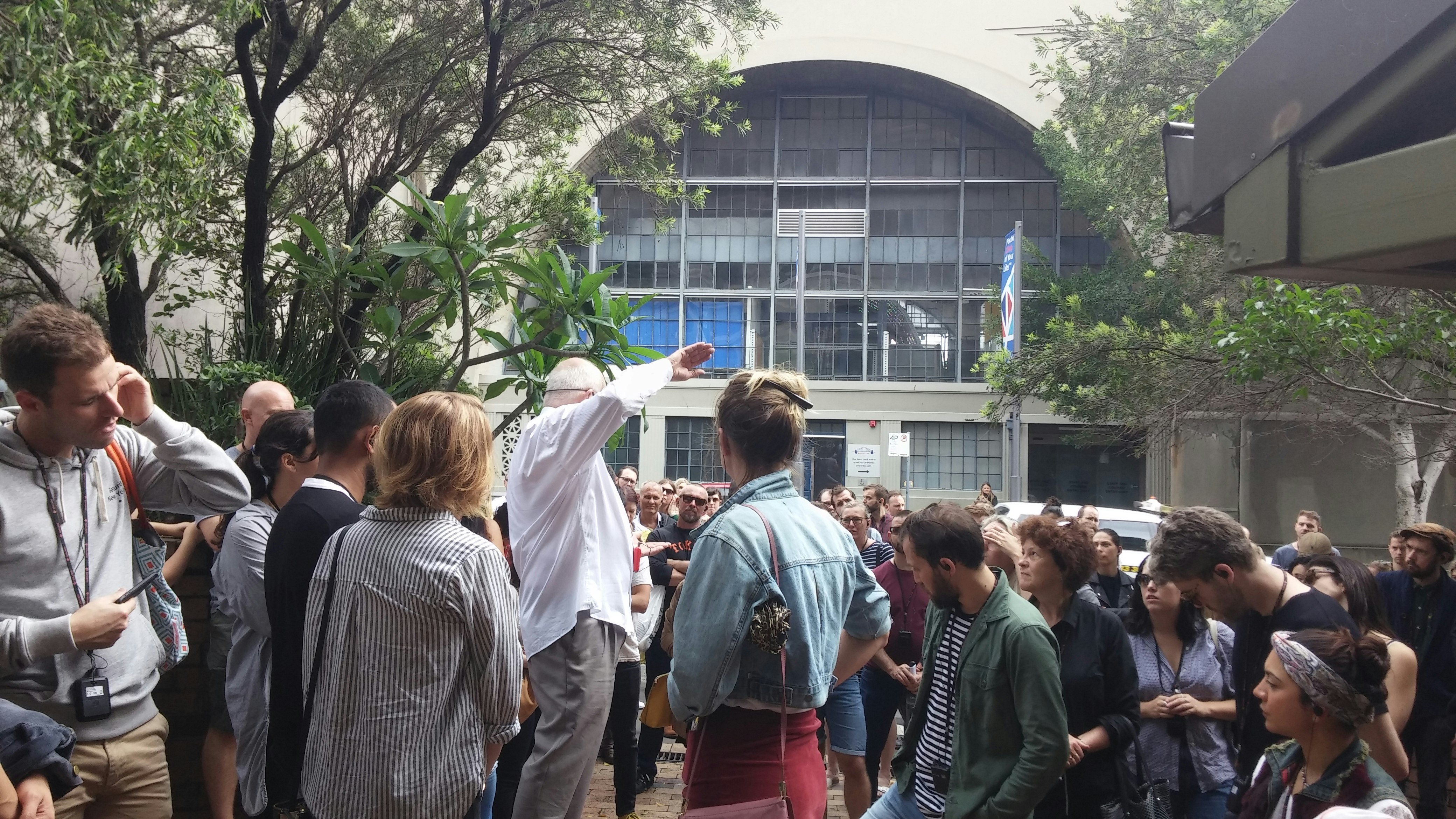
Sirius walking tour conducted during Art Month Sydney, March 2017, and led by the building’s original architect, Tao Gofers; photo: Ella Mudie.
The proposed demolition of Sirius comes at a moment when Brutalist architecture across the world is under threat (7). As such, the design community in Sydney has assumed a prominent role in articulating the value of Sirius and advocating for its preservation. Chaired by architect and former president of the NSW chapter of the Australian Institute of Architects, Shaun Carter, the Save Our Sirius Foundation crowdfunded to mount a legal challenge against the NSW Government’s decision not to heritage list the building. In the months prior to the court hearing, public engagement with Sirius reached a tipping point when walking tours of the building, led by the original architect, Tao Gofers, were added to the Art Month Sydney program. Portrait drawing sessions were also organised with the human face of the campaign—one of two last remaining residents, 90-year-old Myra Demetriou, although these were curtailed when access to the Sirius’s common room was denied.
In what’s become a familiar argument justifying the sale of public assets, the NSW Government argues that demolition of Sirius is necessary to maximise the sales price of the building, which in turn will generate much-needed funds to be reinvested in building more public housing elsewhere. The quasi-teleological bent of this rhetoric implies that the relocation of public housing from the inner-city is both inevitable and natural. Yet the redevelopment policies of a city like Hong Kong, where more than 30 per cent of the city’s population lives in public housing, prove alternate models exist. Here, neither the age of a building nor land value are primary drivers influencing which existing blocks the government’s Housing Authority chooses to redevelop or refurbish. Rather, the proximity of suitable flats nearby to rehouse residents and a concern not to disrupt established social networks and neighbourhood communities, especially among elderly tenants who tend to reside in the older blocks, are key considerations.
For Shaun Carter, the present fixation on the demolition of Sirius is political, a product of the culture wars and internal divisions within the Liberal-National Party coalition between the moderates and conservatives. ‘While most people can appreciate the heritage value of The Rocks precinct, because Sirius is an example of modern heritage a lot of people don’t get it,’ he says. No matter how polarising its design, Sirius is nonetheless ‘a fit-for-purpose building. It’s natural that buildings go in and out of favour over time, but that doesn’t mean that every building that’s fallen out of favour should be demolished. Sirius should continue to be deployed as social and affordable housing, and retaining it would be a win for the Millers Point community and for Sydney and New South Wales because it means keeping an important cultural artefact. To erase Sirius is to take away a physical marker in the landscape. We need these records of our past’ (8).
There was some reprieve for Sirius after the NSW Land and Environment Court ruled in July that the former heritage minister made two errors of law when deciding not to list the building on the State Heritage Register. It now appears short-lived as the NSW Government has again refused to grant the building state heritage status, announcing in late October that the aesthetic value of Sirius was not deemed sufficient to merit protection. Save Our Sirius has countered in a media release that it will continue to fight the demolition and is exploring legal options. Such commitment to advocacy by the design profession is arguably too rare today. Overall employment by government of architects may be declining, however, ‘the notion of the architectural profession should still be to act for the public good and in the public interest,’ says Carter. ‘Architects should be leaders in the community and seek to steer a course toward a place of making better cities’ (9).
Where architects can exercise the ‘social responsibility of their labour,’ to borrow the phrase of Green Ban union activist Jack Mundey, by positively influencing the design of the city, the dismantling in August of a homeless camp installed at Martin Place, known as ‘tent city,’ raises broader questions around the right to the city and for whom the city is built and designed in the twenty-first century (10). Following the global trend towards the revitalisation of downtown precincts, substantial pockets of land have, in recent years, been unlocked in and around the Sydney CBD for such mixed-use developments as Central Park at Broadway and the Barangaroo precincts, both adhering closely to the design and planning principles of new urbanism. And yet the forced removal of scores of Sydney’s homeless from the civic space at Martin Place reveals just how badly the private property market is failing to meet the housing needs of broad segments of the community.
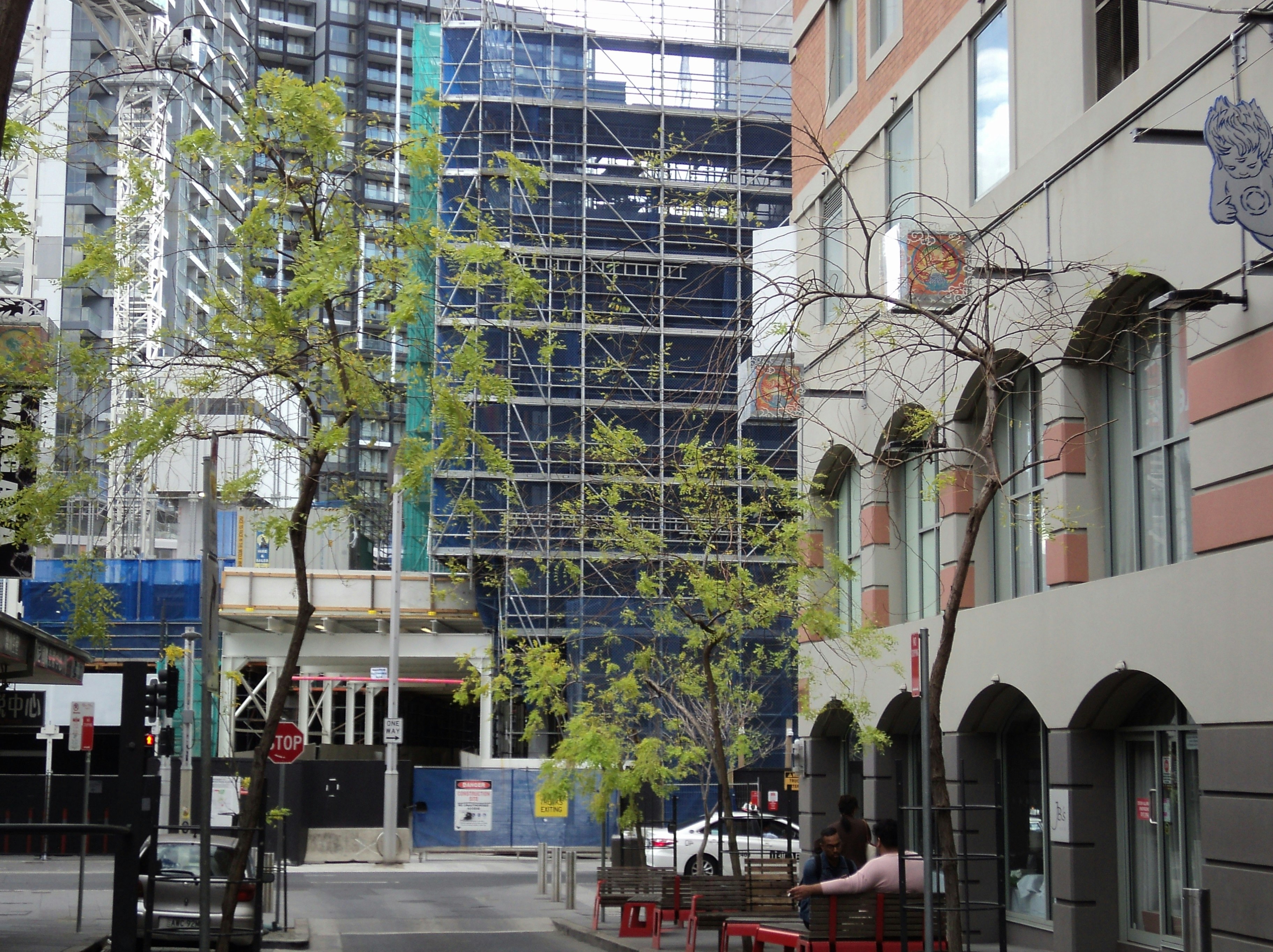
Construction of Darling Square, Haymarket (view from Little Hay Street), September 2017; photo: Ella Mudie.
The forced removal of scores of Sydney’s homeless from the civic space at Martin Place reveals just how badly the private property market is failing to meet the housing needs of broad segments of the community.
Not far from the 4A’s Hay Street location in Haymarket, construction has commenced on the next inner-city development, Lendlease’s Darling Square project, on the site of the former Sydney Entertainment Centre, demolished in 2016. Connecting the Darling Harbour tourist precinct with the western part of Chinatown, Darling Square will comprise a mix of upscale residential apartments, office towers, retail outlets, public space and a plaza building, Darling Exchange, to be designed by renowned Japanese architect Kengo Kuma. Reading through the developer’s marketing collateral, the emphasis on promoting the development as a vibrant neighbourhood is striking. By ‘curating city living, working and shopping experiences to create innovative and engaging destinations, Lendlease is leading the charge when it comes to making cities great,’ so boasts one upbeat article published in the development’s newsletter Square Life (11).
Ultimately, this is neighbourhood living as sales pitch—defined within an ethos of production and consumption, according to which connection is measured in proximity to shops, workplaces, transport and services rather than in terms of relationships between people. In this way, Darling Square embodies what some critics term the ‘consumer citizenships of neoliberalism’ (12). In Sydney, the concerted shift towards fostering global market citizenship has, critics argue, ‘destabilized local citizens’ claims to their urban space—claims that were based on inhabitance and social citizenship—because the “Global Sydney” vision is built around notions of private property and economic progress’ (13). At Darling Square, Lendlease has admirably committed to making 35 per cent of the site available as public space. Yet this can’t negate the fact that with respect to housing, inner-city living in Sydney is increasingly the domain of wealthy private owners. Key workers, renters, and public housing residents are pushed to the city’s suburban fringes.
The MoS media release for Demolished Sydney astutely observes that ‘demolitions have been a constant part of the city’s evolution—sometimes welcomed as a sign of progress, and at other times reviled as a short-sighted obliteration of culture.’ The current battles over threatened architecture in Sydney, occurring side-by-side by a boom in private property developer-led construction, suggests this will be a period in Sydney’s history that is remembered (and, quite likely, reviled) less for the short-sighted obliteration of culture, than for the obliteration of the last vestiges of fairness and egalitarianism in the city’s urban governance.
The efforts mounted by artists and the design community in fostering resistance through such projects as #WeLiveHere2017 and the Save Our Sirius campaign speak to the urgent need for more civic-minded projects in Sydney prepared to wage the struggle for spatial justice. Whatever the outcome, these projects remind us that public art has a far more meaningful role to play in place-making than providing decoration for construction hoardings and satisfying the culture quota for yet another private property developer’s profit maximising urban renewal scheme.
Notes
Notes
(1) James Robertson, ‘Sirius demolition one step closer as state government declines to grant heritage status,’ Sydney Morning Herald, smh.com.au, 25 October 2017.
(2) The density levels proposed for Waterloo are presently unconfirmed. Following the nomination of Waterloo as a State Significant Precinct (SSP), NSW Government will conduct a 12 to 18-month master planning consultation process. Public housing tenant relocations were scheduled to begin in mid-2018 but have since been delayed to 2019.
(3) Clare Lewis, interview with the author, 31 August 2017.
(4) Dallas Rogers, ‘Monitory Democracy as Citizen-driven Participatory Planning: The Urban Politics of Redwatch in Sydney,’ Urban Policy and Research, 34.3, 2016, p. 235.
(5) Proponents of social-mix argue that public housing tenant disadvantage is reduced by living in mixed-income areas however there is little evidence to corroborate the claim that the persistence of poverty is linked to residential concentration. See Michael Darcy, ‘Deconcentration, social mix and poverty,’ presentation to Shelter NSW conference, ‘Estates in the Balance,’ Sydney, 17 June 2010.
(6) Edward W. Soja, Seeking Spatial Justice, Minneapolis: University of Minnesota Press, 2010, p.45.
(7) A product of the post WWII enthusiasm for raw concrete and generally large in scale, many Brutalist buildings were designed for civic functions with a view to longevity now at odds with modern design trends. Glenn Harper details the breadth of local Brutalist buildings under threat in ‘The_Brutalist_Project_Sydney’ (PDF available for download here) Byera Hadley Travelling Scholarships Journal Series, NSW Architects Registration Board, 2016. For a survey of current campaigns to rescue Brutalist architecture around the world see online database sosbrutalism.org
(8) Shaun Carter, interview with the author, 7 September 2017.
(9) Carter, interview with author.
(10) Sirius is a product of the Green Bans, built to rehouse workers’ families displaced by the redevelopment of Millers Point. In September 2016, the Construction, Forestry, Mining and Energy Union (CFMEU) and Unions NSW placed a Green Ban on Sirius meaning that no companies associated with the unions will be involved in the building’s demolition. For more on the Green Bans movement see Meredith Burgmann and Verity Burgmann, Green Bans Red Union: The Saving of a City, 2nd edition, Sydney: New South Press, 2017. The history of Sirius is documented in the forthcoming book Sirius by John Dunn et al, Sydney: Piper Press, 2017.
(11) Lendlease, Square Life issue 3, 2016 edition.
(12) Dallas Rogers and Michael Darcy, ‘Global city aspirations, graduated citizenship and public housing: analysing the consumer citizenships of neoliberalism,’ Urban, Planning and Transport Research, 2.1, 2014, pp. 72-88.
(13) Rogers and Darcy, p. 76.
About the contributor
Ella Mudie is an arts writer and arts administrator from Sydney with broad interests across the visual arts, literature, architecture and design.
